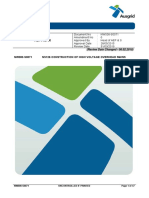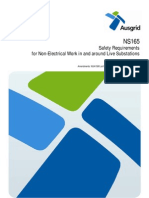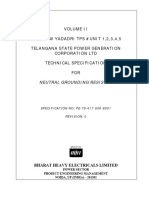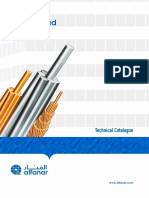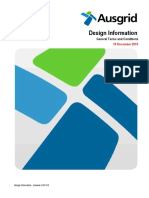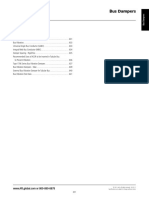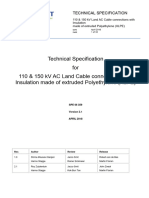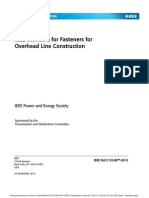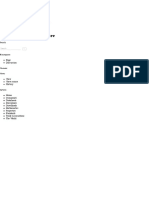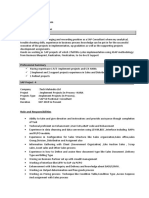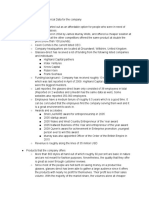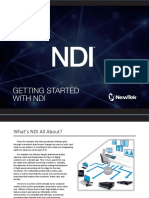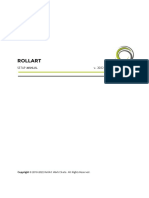NS171
Uploaded by
Philip LonerganNS171
Uploaded by
Philip LonerganNetwork Standard
Document No : NW000-S0035
Amendment No : 0
NETWORK Approved By : Chief Engineer
Approval Date : 27/03/2015
Review Date : 01/11/2016
NW000-S0035 NS171 FIRESTOPPING IN SUBSTATIONS
NW000-S0035 UNCONTROLLED IF PRINTED Page 1 of 37
NS171 Firestopping in Substations Amendment No 0
ISSUE
For issue to all Ausgrid and Accredited Service Providers’ staff involved with the installation of firestopping materials in openings in
substation walls, floors and ceilings in an electrical substation and is for reference by field, technical and engineering staff.
Ausgrid maintains a copy of this and other Network Standards together with updates and amendments on www.ausgrid.com.au.
Where this standard is issued as a controlled document replacing an earlier edition, remove and destroy the superseded document
DISCLAIMER
As Ausgrid’s standards are subject to ongoing review, the information contained in this document may be amended by Ausgrid at any
time. It is possible that conflict may exist between standard documents. In this event, the most recent standard shall prevail.
This document has been developed using information available from field and other sources and is suitable for most situations
encountered in Ausgrid. Particular conditions, projects or localities may require special or different practices. It is the responsibility of
the local manager, supervisor, assured quality contractor and the individuals involved to make sure that a safe system of work is
employed and that statutory requirements are met.
Ausgrid disclaims any and all liability to any person or persons for any procedure, process or any other thing done or not done, as a
result of this Standard.
All design work, and the associated supply of materials and equipment, must be undertaken in accordance with and consideration of
relevant legislative and regulatory requirements, latest revision of Ausgrid’s Network Standards and specifications and Australian
Standards. Designs submitted shall be declared as fit for purpose. Where the designer wishes to include a variation to a network
standard or an alternative material or equipment to that currently approved the designer must obtain authorisation from the Network
Standard owner before incorporating a variation to a Network Standard in a design.
External designers including those authorised as Accredited Service Providers will seek approval through the approved process as
outlined in NUS181 Approval of Materials and Equipment and Network Standard Variations. Seeking approval will ensure Network
Standards are appropriately updated and that a consistent interpretation of the legislative framework is employed.
Notes: 1. Compliance with this Network Standard does not automatically satisfy the requirements of a Designer Safety Report. The
designer must comply with the provisions of the Workplace Health and Safety Regulation 2011 (NSW - Part 6.2 Duties of designer of
structure and person who commissions construction work) which requires the designer to provide a written safety report to the person
who commissioned the design. This report must be provided to Ausgrid in all instances, including where the design was
commissioned by or on behalf of a person who proposes to connect premises to Ausgrid’s network, and will form part of the Designer
Safety Report which must also be presented to Ausgrid. Further information is provided in Network Standard (NS) 212 Integrated
Support Requirements for Ausgrid Network Assets.
2. Where the procedural requirements of this document conflict with contestable project procedures, the contestable project
procedures shall take precedent for the whole project or part thereof which is classified as contestable. Any external contact with
Ausgrid for contestable works projects is to be made via the Ausgrid officer responsible for facilitating the contestable project. The
Contestable Ausgrid officer will liaise with Ausgrid internal departments and specialists as necessary to fulfil the requirements of this
standard. All other technical aspects of this document which are not procedural in nature shall apply to contestable works projects.
INTERPRETATION
In the event that any user of this Standard considers that any of its provisions is uncertain, ambiguous or otherwise in need of
interpretation, the user should request Ausgrid to clarify the provision. Ausgrid’s interpretation shall then apply as though it was
included in the Standard, and is final and binding. No correspondence will be entered into with any person disputing the meaning of
the provision published in the Standard or the accuracy of Ausgrid’s interpretation.
KEYPOINTS
This standard has a summary of content labelled “KEYPOINTS FOR THIS STANDARD”. The inclusion or omission of items in this
summary does not signify any specific importance or criticality to the items described. It is meant to simply provide the reader with a
quick assessment of some of the major issues addressed by the standard. To fully appreciate the content and the requirements of the
standard it must be read in its entirety.
AMENDMENTS TO THIS STANDARD
Where there are changes to this standard from the previously approved version, any previous shading is removed and the newly
affected paragraphs are shaded with a grey background. Where the document changes exceed 25% of the document content, any
grey background in the document is to be removed and the following words should be shown below the title block on the right hand
side of the page in bold and italic, for example, Supersedes – document details (for example, “Supersedes Document Type
(Category) Document No. Amendment No.”).
NW000-S0035 UNCONTROLLED IF PRINTED Page 2 of 37
KEY POINTS OF THIS STANDARD
Firestopping Penetrations (cont.d)
Scope and Risks Addressed Fire Risk & Material Safety Firestopping Penetrations
and Cable Fire Protection
This standard details requirements for the This standard identifies risks relating to the The following specific requirements relate to Access provisions for seals are included for
application of firestopping in openings in spread of fire within substations. These fire stopping of penetrations: cable fault location requirements
walls, ceilings and floors, as well as cable include: Where seals are subject to exposure to
ducts. The standard has he following All services that penetrate building moisture or oil a seal a protective coating
scope/limitations: Spread of fire through openings in the elements required to have a FRL shall will be applied
building structure no matter how small. be sealed unless required otherwise by All existing penetrations that are disturbed
Only applies to openings for electrical Tracking of fire along cables/conduits. this NS171. shall be re-instated to an equivalent or
services, such as cables, electrical Ignition of combustible material Table 1 in this standard nominates the better standard than the original
conduits and busbars subsequent to equipment failure, such minimum FRL required for various Re-instatement of seals should be done on
It does not address firestopping of as oil-filled switchgear. penetration seals. a daily basis prior to leaving site.
other service penetrations. Damage is not limited to effect of fire Where there is any doubt on the extent Where water seals are required do not use
All buildings must comply with the burning and smoke but also fire fighting of penetration seals it should be referred firestopping.
Building Code of Australia with respect activities. to Ausgrid Primary Systems branch. All penetration seals shall be identified
to fire segregation and firestopping. Firestopping should be installed during Penetration seals are not required in Installation certification is required.
Also applies to cables in or adjacent to construction when an a risk assessment some situations in external basement A final inspection of installation works will
the structure including cable risers, deems it to be necessary. walls (Refer Cl. 9.3). be undertaken by Ausgrid
cable turning rooms and pits Temporary fire stopping may be required Penetrations should generally be sealed Cable fire protection can be in the form of
Applies to Ausgrid, ASPs, and where appropriate during construction. at both ends. Special considerations cable coating products, approved cable
contractors, as well as their Safety Data Sheets should be available apply for short penetrations. wraps and blankets or approved flame
employees, working in Ausgrid for all firestopping materials when being Special precautions are required where retardant cable sheaths.
substations installed, removed, disturbed or floor penetrations may become a hazard Cable protection that is part of approved
Aims to minimise risk of fire spread via otherwise interfered with. for pedestrians product specific installation detail must be
electrical services that penetrate All new installations should not use PVC conduits require an intumescent installed.
building elements (walls, floors, inhalable man made mineral fibres seal when the conduits penetrate a Specific cable protection requirements are
ceilings) (MMMF). building element required to have an listed for secondary cables in buildings, HV
Documents product performance The listed precautions should be used FRL. and LV cables within buildings and cable
requirements of firestopping products for existing installations where MMMF is Other services (non-electrical) may coating in external switchyards.
required to achieve Ausgrid approval. confirmed or suspected. require similar penetration treatment. Firestopping products shall be
Asbestos shall not be used or reused at supplied/installed only by Ausgrid approved
any site. installers/suppliers
Where to for more information? Where to for more information? Where to for more information?
Section 6, 7, 8, 9 Section 10 Section 10, 11, 12
Where to for more information? Tools and Forms Tools and Forms Tools and Forms
Section 1, 2, 5 Annexure B - Approved products/materials Annexure D – Flowcharts for firestopping and Annexure A – Firestopping identification
Annexure C – Sealant Properties cable protection Annexure E – Sample Compliance Checksheet
NW000-S0035 UNCONTROLLED IF PRINTED Page 3 of 37
NS171 Firestopping in Substations Amendment No 0
Network Standard
NS171
Firestopping in Substations
Contents
1.0 PURPOSE ............................................................................................................................................. 6
2.0 SCOPE .................................................................................................................................................. 6
3.0 REFERENCES ...................................................................................................................................... 7
3.1 Ausgrid documents .................................................................................................................... 7
3.2 Other standards and documents................................................................................................ 7
3.3 Acts and regulations................................................................................................................... 7
4.0 DEFINITIONS ........................................................................................................................................ 8
5.0 FIRE RISK ........................................................................................................................................... 11
5.1 General .................................................................................................................................... 11
5.2 Fire risk during construction ..................................................................................................... 11
6.0 MATERIAL SAFETY ............................................................................................................................ 12
6.1 General .................................................................................................................................... 12
6.2 Safety data sheets ................................................................................................................... 12
6.3 Existing seals ........................................................................................................................... 12
6.3.1 Man-made mineral fibres (MMMF) ............................................................................... 12
6.3.2 Asbestos....................................................................................................................... 13
7.0 ASBESTOS .......................................................................................................................................... 13
8.0 FIRESTOPPING OF PENETRATIONS ............................................................................................... 13
8.1 General .................................................................................................................................... 13
8.2 Fire rating of penetration seals ................................................................................................ 13
8.3 Basement penetration seals .................................................................................................... 15
8.4 Sealing of elongated penetrations ........................................................................................... 15
8.5 Structural adequacy of penetrations through floors ................................................................. 16
8.6 PVC conduits ........................................................................................................................... 16
8.7 Penetrations for Other Services ............................................................................................... 16
8.8 Provision of Access Points for Cable Fault Location ............................................................... 17
8.9 Access points for further cable access .................................................................................... 17
8.10 Protective coatings for seals .................................................................................................... 17
8.11 Reinstating existing penetration seals ..................................................................................... 17
8.11.1 Requirements ............................................................................................................... 17
8.11.2 Reinstating large penetration seals .............................................................................. 17
8.12 Water seals .............................................................................................................................. 17
8.13 Signage and identification ........................................................................................................ 18
8.14 Installation certification ............................................................................................................. 18
8.14.1 New installations .......................................................................................................... 18
8.14.2 Cable slots.................................................................................................................... 18
8.14.3 Long term management ............................................................................................... 18
8.15 Final inspection ........................................................................................................................ 18
9.0 CABLE FIRE PROTECTION ............................................................................................................... 19
9.1 General .................................................................................................................................... 19
NW000-S0035 UNCONTROLLED IF PRINTED Page 4 of 37
NS171 Firestopping in Substations Amendment No 0
9.2 Protection for cable penetration seals...................................................................................... 19
9.3 Secondary cables in buildings ................................................................................................. 19
9.3.1 Control rooms ............................................................................................................... 19
9.3.2 Basements, trenches, cable risers and other internal locations .................................. 19
9.4 HV and major LV cables in basements, trenches, cable galleries and vertical surface mounted
cables within buildings ......................................................................................................................... 20
9.5 Cable coating in external switchyards...................................................................................... 21
10.0 AUSGRID LIST OF APPROVED PRODUCTS AND PRODUCT SPECIFIC INSTALLATION DETAILS
21
11.0 RECORDKEEPING ............................................................................................................................. 22
12.0 AUTHORITIES AND RESPONSIBILITIES .......................................................................................... 22
13.0 DOCUMENT CONTROL...................................................................................................................... 22
ANNEXURE A – FIRESTOPPING SEAL IDENTIFICATION AND DETAILS MARKERS ............................... 23
ANNEXURE B – AUSGRID’S APPROVED PRODUCT SPECIFIC INSTALLATION DETAILS ..................... 24
ANNEXURE C – SEALANT PROPERTIES .................................................................................................... 26
ANNEXURE D – FLOWCHARTS .................................................................................................................... 28
ANNEXURE E – SAMPLE COMPLIANCE CHECKLIST ................................................................................ 35
NW000-S0035 UNCONTROLLED IF PRINTED Page 5 of 37
NS171 Firestopping in Substations Amendment No 0
1.0 PURPOSE
This Network Standard for the installation of firestopping materials in openings in substation walls,
floors and ceilings applies in particular to penetrations caused by cables, cable ducts, encased
busbars and other openings unique to an electrical substation.
This standard also deals with firestopping around Poly Vinyl Chloride (PVC) (including
Unplasticised Poly Vinyl Chloride (UPVC)) and similar electrical conduits where they pass through
walls and floors.
The primary objectives of this Network Standard are:
to minimise fire spread via electrical services that penetrate substation building elements
(walls, floors and ceilings) that are required to have an FRL or a resistance to the incipient
spread of fire.
to document the product performance requirements that suppliers of fire stopping products
shall meet to achieve approval from Ausgrid to supply these products.
Firestopping materials and products used in Ausgrid substations shall comply with the
requirements of this Network Standard. A list of currently approved product specific installation
details is included in Annexure B of this Network Standard.
All requests for variations to this Network Standard shall be undertaken using the approval process
outlined in NUS181 Approval of Materials and Equipment and Network Standard Variations.
2.0 SCOPE
This Network Standard is Ausgrid’s specification and requirements for the installation of
firestopping materials in openings in substation walls, floors and ceilings. The openings referred to
include holes, slots and other penetrations for electrical services, such as cables, electrical
conduits and busbars. This document does not address fire stopping of other service penetrations.
The requirements of this Network Standard apply to all substations and similar installations. In
addition to this Network Standard, all buildings must comply with the Building Code of Australia,
Australian Standards and any other relevant codes and standards in respect to fire segregation and
firestopping for the purpose of maintaining structural adequacy, integrity and insulation.
The requirements of this Network Standard also apply to associated cable installation facilities
external to a substation chamber, but contained in or adjacent to the structure housing the
substation, including cable risers, cable turning rooms and pits.
This Network Standard applies to all persons; including Ausgrid staff, Accredited Service Providers,
Contractors, sub-contractors and associates, and employees of any of the above and any other
persons involved with electrical and/or construction work in substations.
The requirements of other relevant Network Standards shall also be complied with.
NW000-S0035 UNCONTROLLED IF PRINTED Page 6 of 37
NS171 Firestopping in Substations Amendment No 0
3.0 REFERENCES
3.1 Ausgrid documents
Company Procedure (Network) - Production / Review of Network Standards
Company Procedure (Governance) – Network Technical Document Endorsement and Approval
Company Form (Governance) - Network Technical Document Endorsement and Approval
Electrical Safety Rules
Electricity Network Safety Management System Manual
NS187 Passive Fire Mitigation Design of Substations
NS212 Integrated Support Requirements for Ausgrid Network Assets
NUS181 Approval of Materials and Equipment and Network Standard Variations
NUS211 Working With Asbestos Products
3.2 Other standards and documents
All relevant WorkCover documentation.
AS/NZS 1170 Structural design actions – Series
AS 1530.4 Methods for fire tests on building materials, components and structures - Fire-
resistance test of elements of construction
AS 1851 Maintenance of fire protection systems and equipment
AS 2865 Confined spaces
AS 3600 Concrete structures
AS 4072.1 Components for the protection of openings in fire-resistant separating elements -
Service penetrations and control joints
AS 4100 Steel structures
ENA Doc 001-2008 National Electricity Network Safety Code
The National Occupational Health and Safety Commission’s NOHSC:3002(1988) and
NOHSC:2002(1988)
Underwriter Laboratory Standard UL 1479 ‘Fire Test on Through Penetration Fire Seals’,
3.3 Acts and regulations
Building Code of Australia
Electricity Supply (General) Regulation 2014 (NSW)
Electricity Supply (Safety and Network Management) Regulation 2014
Work Health and Safety Act 2011 and Regulation 2011
NW000-S0035 UNCONTROLLED IF PRINTED Page 7 of 37
NS171 Firestopping in Substations Amendment No 0
4.0 DEFINITIONS
Access Permit Refer to Ausgrid Electrical Safety Rules.
Approved Installer An Accredited Service Provider (ASP) who has been trained and
nominated in writing by an Approved Supplier of firestopping product.
Note: Ausgrid may have additional safety training requirements depending
on where the product is being installed. Refer to Ausgrid Project
Development.
Approved Product List of products attached in Annexure B which satisfy the requirements
listed in Annexure C Sealant Properties. To be used in locations identified
in this Network Standard. These approved products shall be installed in
accordance with Ausgrid’s Approved Product Specific Installation Details.
Approved Product Listed in Annexure B
Specific Installation
Details
Approved Supplier Listed in Annexure B
Accredited Service An individual or entity accredited by the NSW Government Trade &
Provider (ASP) Investment in accordance with the Electricity Supply (Safety and Network
Management) Regulation 2014 (NSW).
Ausgrid Primary A section in the Ausgrid organisational structure within the Chief
Systems Engineer’s Division.
Business An Ausgrid internal integrated policy and procedure framework that
Management contains the approved version of documents.
System (BMS)
Cable Bricks An intumescent rectangular or plug shaped brick with a firm spongy
texture. They are fire rated and tested for use with cables and satisfy the
requirements of Annexure C, Sealant Properties.
Cable Coating A coating that provides heat protection to cables not by thermal insulation
but by an endothermic reaction. Large amounts of heat energy are
required to decompose the coating, thus the reaction takes heat away
from the cable. The coating shall comply with the requirements of
Annexure C, Sealant Properties.
Cable Mortar A mortar that is fire rated and tested for use with cables, and satisfies the
requirements of Annexure C, Sealant Properties.
Cable Putty An intumescent putty with the texture of firm plasticene. It is fire rated and
tested with cables and satisfies the requirements of Annexure C Sealant
Properties.
Compartmentalise To separate a compartment from others by providing fire rated seals to
any penetration that is common between compartments.
Document control Ausgrid employees who work with printed copies of document must check
the BMS regularly to monitor version control. Documents are considered
“UNCONTROLLED IF PRINTED”, as indicated in the footer.
Endothermic A process by which energy is consumed when any material is changed
Reaction from one state to another.
Expandable Expands during the setting process.
Factory Mutual An insurance organisation that provides testing and approvals for
firestopping products to be used for specific applications.
Fire Collar A pre-fabricated penetration seal system for PVC conduits. Collars shall
NW000-S0035 UNCONTROLLED IF PRINTED Page 8 of 37
NS171 Firestopping in Substations Amendment No 0
be type tested and shall satisfy the requirements of Annexure C, Sealant
Properties.
Fire Pillows Fire rated bags that resemble pillows that are specifically for sealing
penetrations where cables pass through walls etc. Fire pillows shall be
type tested and shall satisfy the requirements of Annexure C, Sealant
Properties.
Fire Rating The period that a firestopped seal will withstand the fire test without
permitting the passage of flame through openings, or the occurrence of
flaming on any element of the unexposed side of the seal.
Firestopping Measures that are adopted to prevent the spread of fire, smoke, and acid
residues from one compartment to another.
Fire Resistance The ability of an element of construction, component or structure to
Level (FRL) maintain its structural adequacy, integrity and thermal insulation during
exposure to a fire for a specific fire resistance period.
Fuel Source Any combustible item that will burn and will sustain a fire; such as some
type of cable insulation (PVC, XLPE, HDPE etc), oil, paper, timber, etc.
Concrete, porcelain, bare copper conductors, and other exposed steel or
metallic objects are not considered to be fuel sources.
Ignition Source A source of energy sufficient to ignite a flammable atmosphere
Intumescent Expands when heated.
Major LV Cables Cables associated with the auxiliary transformer supply, main AC
switchboards and submains.
Mastic Sealant A sealant that can be used to provide a gas seal only.
Moisture Intermittent exposure to water such as by rain and does not submerge the
seal.
Network Standard A document, including Network Planning Standards, that describes the
Company's minimum requirements for planning, design, construction,
maintenance, technical specification, environmental, property and
metering activities on the distribution and transmission network. These
documents are stored in the Network Category of the BMS repository.
Penetration The aggregated cross sectional area of cables or busbars that occupy a
Loading related cross sectional area of a penetration.
Penetration Seals The fire-stopping system used to seal openings in walls, floors or ceilings
that carry cables or busbars.
Pre-seal A seal that is formed outside the penetration usually due to penetrations
congested with cables (more than 60% of the penetration occupied by
cables). Can also be used where there is insufficient depth in the opening
to accommodate the seal.
Project A branch under the Ausgrid organisational structure
Development
Review date The review date displayed in the header of the document is the future
date for review of a document. The default period is three years from the
date of approval however a review may be mandated at any time where a
need is identified. Potential needs for a review include changes in
legislation, organisational changes, restructures, occurrence of an
incident or changes in technology or work practice and/or identification of
efficiency improvements.
Secondary Cables Cables used within a substation for control, protection, communications
NW000-S0035 UNCONTROLLED IF PRINTED Page 9 of 37
NS171 Firestopping in Substations Amendment No 0
and metering purposes.
Submersion Where one side of a seal is completely covered in a depth of water for a
short or long period of time
Substation Includes sub-transmission substations, zone substations, switching
stations, distribution substations, customer substations, control points,
chambers for control and metering of supply to high voltage connections
(HVCs), and any other installations where contract documents or other
instructions specify that this Network Standard is to apply.
Temperature Rating The temperature rise above initial, on the exposed face of a sample due to
transmission of heat during the rating period, measured by any
thermocouple on the exposed face.
The transmission of heat through the sample during the rating period shall
not raise the temperature measured by any thermocouple on the exposed
face by more than 180C above its initial temperature.
Temporary Firestopping intended to remain in service for a short period of time.
Firestopping Typically, the duration shall not exceed six (6) months and shall be
significantly less at high risk locations. Approval is required for any longer
durations due to work sequencing, staged equipping etc.
Trafficable area Any area in a floor, corridor or passageway where there are no barriers in
place to prevent persons from stepping on the seals.
Underwriter An insurance organisation that provides testing and approvals for
Laboratory firestopping products to be used for specific applications
NW000-S0035 UNCONTROLLED IF PRINTED Page 10 of 37
NS171 Firestopping in Substations Amendment No 0
5.0 FIRE RISK
5.1 General
Without firestopping, a fire may spread and destroy other parts of the substation building simply by
finding its way through any penetration no matter how small.
The fire propagation velocity for PVC insulated cable bundles can be 20 m/m (metres/minute) for
vertical installation, and 5 m/m for horizontal installation, as determined by the British Central
Electricity Generating Board (CEGB). Other types of plastic insulation, such as polyethylene or
polypropylene will propagate fire more quickly.
Standard concrete or sand cement is not fire rated when used as a sealant where cables pass
through penetrations.
A fire that is tracking along a cable may pass through a penetration that has been sealed with
standard concrete or sand cement and will possibly burst out the sealant in the process.
In addition to generic fire ignition sources (e.g. human error), fires could also be started when oil
filled electrical equipment such as transformers or oil filled switchgear fail. When this occurs, the
fire is fuelled by the oil and also possibly by bituminous compound in busbar compartments or end
boxes. Other fuel sources include the secondary, HV and LV cables and the low voltage boards.
Importantly, the damage to a substation is not just limited to the spread of flames, but includes the
damage caused by fire fighting and the spread of hydrochloric acid and smoke damage from any
burning PVC coated secondary cables.
Firestopping limits the extent of cable and equipment damage and the amount of fire spread from
burning cable insulation.
5.2 Fire risk during construction
A risk assessment shall be conducted to identify the appropriate stages of the construction and/or
commissioning processes that firestopping is to be installed.
The risk assessment should be undertaken by a person or persons competent in assessing the fire
risks. Based on the findings of the risk assessment, penetrations shall be fire stopped where
deemed to be necessary. Penetrations that do not have cables in place as yet shall also be
considered.
The firestopping in new buildings shall be installed in stages in accordance with the risk
assessment. During these stages, the use of easily installed and removable firestopping such as
fire pillows may be more appropriate.
The progressive installation of firestopping shall be included as a check item in inspections
conducted by Ausgrid’s Equipping Manager.
The risk assessment shall consider and document the following items when performing the
assessment:
(a) Most accidents occur when commissioning new equipment.
(b) All non ventilation openings should be considered, not just openings carrying cables.
(c) Building fire systems may not be fully operational.
(d) Fire zoning into multiple compartments should be considered where substation design permits.
(e) Fire rated protection to cables by boxing in cables may be necessary in high risk locations.
This will also provide mechanical protection.
(f) Re-instating firestopping on a daily basis should be considered during installation of
equipment.
(g) Hot work may occur during construction and cable jointing.
(h) Storage of materials and building refuse will occur during construction.
NW000-S0035 UNCONTROLLED IF PRINTED Page 11 of 37
NS171 Firestopping in Substations Amendment No 0
(i) The cost and risk associated with loss of equipment if a fire occurred prior to or after
commissioning should be assessed.
During the installation of equipment, consideration should be given to installing temporary
firestopping where appropriate.
Prior to commissioning equipment in new substations or altering existing substations, the
associated fire stopping for that equipment and compartment shall be fully installed.
Firestopping needs shall be continuously monitored during all phases of construction and
commissioning.
6.0 MATERIAL SAFETY
6.1 General
Both new and existing firestopping materials may contain harmful ingredients and appropriate
measures must be taken to manage any risks.
6.2 Safety data sheets
A copy of current Safety Data Sheets (SDS) shall be readily available at all times when firestopping
products are being installed, removed, disturbed or interfered with in any way. These SDS's are
required by WHS legislation and must be provided for all products.
Safety Data Sheets (SDS) shall be followed and complied with when using firestopping materials.
Safe Work Method Statements must be provided and contain the safe method of work to be
followed including storage, handling, disposal and clean up after use. All staff and contractors (
including ASPs ) must be trained in the application of the Safe Work Method Statements.
6.3 Existing seals
6.3.1 Man-made mineral fibres (MMMF)
Some existing fire seals may contain inhalable Man Made Mineral Fibres (MMMF). There are now
alternate products that do not contain inhalable MMMF and these shall be used for all new
installations.
Where existing seals containing MMMF need to be disturbed or removed, precautionary measures
shall be used to mitigate against the potential hazards associated with this material. The
requirements shall consist of the following;
(a) Personal protective equipment (PPE) equivalent to "Level 1" under the Work Procedures
General of NUS211 Working with Asbestos Products, and consisting of:
(i) half face respirator with P2 particulate filter
(ii) disposable Nitrile gloves or leather gloves
(iii) gum boots or boot covers
(b) Material potentially containing MMMF shall be wetted down using water or a wetting agent like
PVA/water solution prior to removal. The removal procedure shall be designed to minimise
and control the generation of dust using a water spray method when applicable and the careful
application of hand tools. Power tools shall not be used unless a procedure has been
approved that specifically allows their use.
(c) All waste material potentially containing MMMF shall be single bagged in heavy duty low
density 200m thick polyethylene bags. Currently, the waste classification of this material is
General solid waste (in accordance with DECCW's Waste Classification Guidelines) and
disposal can be into general waste bins.
NW000-S0035 UNCONTROLLED IF PRINTED Page 12 of 37
NS171 Firestopping in Substations Amendment No 0
6.3.2 Asbestos
Some existing fire seals may contain asbestos, in particular old NC compound. Additionally, some
duct lines and cable bandage tape may also contain asbestos. Refer to Section 7.0 Asbestos.
7.0 ASBESTOS
Asbestos shall not be reused. Refer to Ausgrid’s Asbestos Location Register for details on
asbestos locations. Removal and disposal of asbestos shall be in accordance with NS211 and to
The National Occupational Health and Safety Commission’s NOHSC: 3002 (1988) and NOHSC:
2002(1988) requirements.
8.0 FIRESTOPPING OF PENETRATIONS
8.1 General
Unless indicated otherwise by this Network Standard, all services that penetrate building elements
that are required to have a Fire Resistance Level (FRL) or a resistance to the incipient spread of
fire shall be sealed to provide compartmentalisation. Where the requirements for the extent of
compartmentalisation is not clear refer to Ausgrid’s Network Standards, Annexure B of this
document and Ausgrid Primary Systems for direction.
8.2 Fire rating of penetration seals
NS187 Passive Fire Mitigation Design of Substations nominates the minimum FRL required for the
various building compartments and elements affected by potential fire sources.
On this basis, Ausgrid’s approved penetration seals are required to achieve a fire rating as
indicated in Table 1 below (derived in part from NS187).
NW000-S0035 UNCONTROLLED IF PRINTED Page 13 of 37
NS171 Firestopping in Substations Amendment No 0
Table 1 – Minimum fire rating of penetration seals – Fire source
Minimum Fire Resistance Period (hours) to
protected equipment or building elements
Fire Source
Distribution &
CBD Zone STS Zone
Chambers
Transformer/reactors – oil filled 3 (Note 4) 3 (Note 4) 3 3
(external & internal)
Transformers non-oil filled (external & 3 3 2* 2*
internal)
Distribution centre Oil Filled 3 (Note 4) 3 (Note 4) 3 3
Distribution centre Non-oil Filled 3 3 2* 2*
Other oil filled equipment 3 (Note 4) 3 (Note 4) 3 3
Other non oil filled equipment 3 Not required Not required 2*
except for BCA except for BCA
compliance. compliance.
Cable marshalling areas (basements 3 (Note 4) 3 (Note 4) Not required 3
etc) (see Note 5.) except for BCA
compliance and
Clause 8.3
Cable Risers 3 (Note 4) 3 (Note 4) 3 3
Control Room 3 Not required Not required N/A
except for BCA except for BCA
compliance. compliance.
Battery Room (where provided) 3 Not required Not required N/A
except for BCA except for BCA
compliance. compliance.
Battery Enclosures Non- Non- Non- N/A
combustible combustible combustible
Communication Room (where provided) 3 Not required Not required N/A
except for BCA except for BCA
compliance. compliance.
Capacitors (where provided) 3 3 2* N/A
* Refer to Project Development for suitable penetration seal design details.
Table 2 – Minimum fire rating of penetration seals - Function
Minimum Fire Resistance Period (hours)
Function Distribution &
CBD Zone STS Zone
Chambers
Amenities, foyers and other areas not Not required Not required Not required Not required
containing substation equipment except for BCA except for BCA except for BCA except for BCA
compliance. compliance. compliance. compliance.
Audio Frequency Load Control (AFLC) N/A Not required Not required N/A
except for BCA except for BCA
compliance. compliance.
Notes: 1. Penetration seals shall adopt the highest fire rating applicable to either side of the
building element being penetrated.
2. The fire rating of all penetration seals shall meet or exceed the fire resistant period
noted in this Table.
3. Ausgrid may require a higher fire resistant period than those nominated in Table 1
for specific sites where loss of supply and/or safety issues dictate.
NW000-S0035 UNCONTROLLED IF PRINTED Page 14 of 37
NS171 Firestopping in Substations Amendment No 0
4. Applicable only to the penetration seals at these locations. A higher fire resistant
period (4 hours) is required by NS 187 for the associated building elements to
ensure survival and re-use of the structure.
5. Penetration seals may not be required for conduits in external basement walls under
specific conditions. Refer to Clause 8.3.
The penetration seals are also required to achieve an equivalent temperature rating. However
where this is not possible due to heat transfer through the cable core, suitable cable fire protection
is to be provided over a minimum length of 300mm to prevent the cable from igniting on the other
side. Refer to Annexure B for approved penetration seals.
In some instances a higher fire and temperature rating may be required by the BCA or other
relevant specification, code or standard. Where a greater fire rating is required, refer to Ausgrid
Primary Systems.
A reduced fire rating may be acceptable for short-term, temporary penetration seals installed during
the equipping and commissioning stages. Where a reduced fire rating is proposed, refer to Ausgrid
Primary Systems.
Ausgrid may accept alternative designs for penetration seals where the approved penetration seals
are deemed to be unsuitable. Alternative designs shall meet or exceed the performance
requirements for approved penetration seals and shall have a relevant testing certificate. All
alternative designs shall be subject to the written approval of Ausgrid Project Development.
Annexure D, Figure D.1 provides a flowchart which summarises the requirements of this Network
Standard for firestopping using penetration seals.
8.3 Basement penetration seals
Penetration seals are not required for conduits in external basement walls provided the conduits
comply with all of the following requirements;
are buried below ground or fully encased outside the basement wall; and
do not lead to any oil filled equipment enclosures (e.g. transformers); and
do not enter an adjacent cable installation facility within a distance of 10m; and
are clearly labelled as external conduits within the basement; and
have been granted prior approval by Ausgrid for deletion of the penetration seal at specific
locations.
All other conduits in external basement walls shall have appropriate penetration seals applied in
accordance with this Network Standard.
Conduits in external basement walls may require the use of water seals to prevent the ingress of
water into the basement. Refer to Clause 8.12 for requirements relating to water seals.
8.4 Sealing of elongated penetrations
Where penetration seals are required, conduits, ducts and cable risers that penetrate a building
element shall generally be sealed at both ends.
The purpose of sealing both ends is to ensure that no penetration seals will be missed. There is
also a possibility that if both ends were not sealed, a fire would spread to other parts of the building
via a wall cavity or void between the faces of the walls.
For short penetration lengths, a one-sided penetration seal may be permitted where all of the
followings requirements are satisfied:
the penetration is less than 500mm in length; and
there is no cavity or void in the wall or floor element; and
the penetration seal is visible from the other side.
Where applied to suspended floors, one-sided penetration seals shall be applied to the underside
(ceiling side) of the floor.
NW000-S0035 UNCONTROLLED IF PRINTED Page 15 of 37
NS171 Firestopping in Substations Amendment No 0
8.5 Structural adequacy of penetrations through floors
Pedestrian traffic on fire seals is to be prevented as a person could fall through the penetration and
the seal can be damaged. Therefore the measures indicated below are required to protect the seal
and to prevent pedestrians from falling through.
1. The following are all the requirements for cable penetrations in corridors, passageways or
floors where pedestrian loading is possible:
(a) Provide handrails where possible to prevent traffic over the seal or provide trafficable
deck plates over seal with a 20 mm gap underneath.
(b) Paint ‘No Step’ on the seal at 1.5 metre intervals and at open sections.
(c) Provide support underneath for accidental pedestrian loading.
2. The following are all the requirements for cable penetrations greater than 200 mm in width in
non-trafficable areas:
(a) Paint ‘No Step’ on the seal at 1.5 metre intervals and at open sections
(b) Provide support underneath for accidental pedestrian loading
3. The following are all the requirements for cable penetrations less than 200 mm in width in
non-trafficable areas:
(a) Paint ‘No Step’ on the seal at 1.5 metres intervals and at open sections
(b) Provide Support underneath for dead weight of seal.
Any structural supports shall conform to relevant Australian Standards including, but not limited to:
AS/NZS 1170 Structural design actions – Series
AS 3600 Concrete structures
AS 4100 Steel structures
The underneath supports of fire seals shall be designed for an accidental loading of 1 kN point load
or 0.25 kPa whichever is greater. Trafficable deck plates shall be designed in accordance with the
loading requirements in AS/NZS 1170.
8.6 PVC conduits
Exposed internal PVC conduits (e.g. VESDA, small wiring etc) can provide a fuel source. Unless
treated with the appropriate seal, they allow a fire to be easily spread by the conduit giving way
when heated, or through the inside of the pipe itself, or along the cables inside.
To prevent the spread of fire in conduits, an intumescent seal is required for those building
elements required to have a FRL. An approved intumescent seal is detailed in Annexure B,
Drawing A4-125652.
Where waterproofing of the conduits is also a requirement alternate approved firestopping
measures shall be used. Refer to Clause 8.12.
Note: This Network Standard addresses electrical conduits only.
8.7 Penetrations for other services
This Network Standard covers electrical services only, however, appropriate consideration shall be
given to all other service penetrations. Where penetration seals are required, these shall be
installed to provide a fire and temperature rating in accordance with this Network Standard.
Note: The BCA requires all services running through fire barriers to be firestopped without
exception. In some instances, the BCA or other relevant standard may require a higher
fire rating.
NW000-S0035 UNCONTROLLED IF PRINTED Page 16 of 37
NS171 Firestopping in Substations Amendment No 0
8.8 Provision of access points for cable fault location
Where floor penetration seals are required below a group of high voltage switchgear, an access
point shall be provided near the switchgear group for temporary installation of earth cables during
cable fault location.
The access point shall be a 125 mm diameter PVC conduit through the full thickness of the seal.
The PVC conduit shall be filled with a fire pillow, which can be removed during fault location, and
reinstated afterwards. Where sheeting supports the seal, the 125 mm diameter PVC conduit shall
be located over a 50 mm diameter hole in the sheeting.
Note: The requirements of this clause do not apply to distribution substations.
8.9 Access points for further cable access
Where large mortar seals are provided and it is envisaged that frequent future access is required,
spare conduits shall be placed as needed to allow easy access and resealing for additional cables.
Refer to Annexure B, Drawing A4-128118 for details.
This does not apply to switchgear cable slots where the requirements of Clause 8.8 apply.
8.10 Protective coatings for seals
Where required, a protective coating will be provided to protect the seal from exposure to moisture
such as rain (not submersion) or oil. Refer to Annexure B for approved protective coatings.
8.11 Reinstating existing penetration seals
8.11.1 Requirements
All existing penetration seals which are disturbed by new works in the substation shall be reinstated
to a level that is equivalent, or better, than the original seal.
Existing penetration seals that are partially disturbed shall be reinstated using the same approved
product as the original seal. Where this cannot be achieved, the entire seal shall be replaced using
the approved product specific installation details included in Annexure B.
The reinstatement of existing firestopping shall be the direct responsibility of the works Project
Manager. Reinstatement of fire stopping and shall be included as a check item in the routine and
final inspections of works on site to be conducted by the Site Manager.
Disturbed penetration seals shall be reinstated prior to leaving the site on a daily basis. During
ongoing site works the use of easily installed and removable temporary firestopping such as fire
pillows may be appropriate.
Where an entire seal has been removed or disturbed it shall be reinstated in accordance with this
Network Standard. See Clause 8.11.2 below for reinstatement requirements for larger penetrations.
Any structural support systems and signs shall be reinstated to this Network Standard and made
safe at all times.
8.11.2 Reinstating large penetration seals
Where a small amount of disturbance has occurred in a large penetration, eg a new cable in a long
switchgear cable slot, advice shall be sought from Ausgrid Project Development for requirements
for reinstating the seal prior to removing the material.
For large disturbances the entire seal shall be replaced in accordance with this Network Standard.
8.12 Water seals
Where water seals are required, do not use firestopping products. There is no guarantee that
some firestopping products will work if submerged for any length of time. Additionally, non-porous
fire seals may dislodge due to head pressure. Water proofing of substations is not covered in this
Network Standard.
NW000-S0035 UNCONTROLLED IF PRINTED Page 17 of 37
NS171 Firestopping in Substations Amendment No 0
At locations where an effective water seal cannot be provided, consideration should be given to
suitable drainage of firestopping products using a small diameter drainage line or appropriate
spacing of cable pillow seals.
8.13 Signage and identification
Each compartment that has been fire sealed is to be provided with a firestopping sign as detailed in
Annexure A.
All penetration seals shall be identified using a suitable system which allows for ease of reference
and future maintenance. The identification of each seal shall include the following information as a
minimum;
A unique number for the site
A general location marker (i.e. BA = Basement)
The date of installation
The product name or material used for the seal
Where possible, the numbering system should align with the conduit numbering adopted for the
substation.
8.14 Installation certification
Certification is required to ensure the product is installed or applied to the manufacturer’s
requirements.
8.14.1 New installations
It is the responsibility of the approved installer to provide certification that all seals are installed to
the manufacturer’s requirements. The approved installer shall certify that they have undertaken the
firestopping in accordance with this Network Standard and the manufacturer’s recommendations.
Certification documentation or otherwise must be provided to Ausgrid Project Development.
8.14.2 Cable slots
Where the top of the penetration seal is not visible (eg in a slot between a switch room and a cable
basement, where switchgear restricts access to the top of the slot), it will be necessary to measure
the seal installation depth by other means, such as by obtaining an Access Permit and opening a
panel to test the depth.
The tool used to test the depth shall be non-conductive and not damaging to cable sheaths. A
suitable tool may be made from a section of PVC conduit, of diameter not more than 25 mm, and
with the end bevelled on the outside at 30 to the axis of the conduit.
The hole made by the tool shall be restored with penetration seal product equivalent to the original,
for the full depth of the seal, promptly after the depth test has been completed.
8.14.3 Long term management
Regular inspection and maintenance is required to ensure the integrity of fire segregation. Also
refer to the requirements of the Building Code of Australia.
8.15 Final inspection
Following completion of the installation works, Ausgrid Project Development, or its delegated
representative, shall arrange for a final inspection and sign-off to ensure that the extent of
installation works comply with the requirements and intent of this Network Standard.
The “approved installer” shall rectify any defects or outstanding items identified and shall undertake
any additional works where directed by Ausgrid.
NW000-S0035 UNCONTROLLED IF PRINTED Page 18 of 37
NS171 Firestopping in Substations Amendment No 0
9.0 CABLE FIRE PROTECTION
9.1 General
Cable fire protection can be in the form of approved cable coating products, approved cable wraps
and blankets, or approved flame retardant cable sheaths.
The extent of approved application of cable fire protection is detailed below. All other applications
of cable fire protection shall be assessed on a site by site basis and prior written authorisation
obtained from Ausgrid Primary Systems.
The objective behind fire protection of cables is to remove the ability of a cable to provide a fuel
source in a fire.
Annexure D, Figure D2 provides a flowchart which summarises the requirements of this Network
Standard for cable fire protection.
9.2 Protection for cable penetration seals
Cable fire protection that is shown as part of an approved product specific installation detail (refer
to Annexure B) must be installed.
Cable fire protection at these locations is required as a part of a cable penetration seal to prevent
the cable from igniting due to heat conduction along the cable core.
9.3 Secondary cables in buildings
9.3.1 Control rooms
Secondary cables located within a control room shall not be cable fire protected unless approved in
writing by Ausgrid Primary Systems.
Where cable fire protection is deemed necessary and cables enter control or protection panels, the
cable fire protection shall not extend into the panel.
Cable identification tags are to be kept free of any coating.
9.3.2 Basements, trenches, cable risers and other internal locations
Secondary cables should be segregated from the following potential hazards wherever possible:
Arc chutes on IAC switchgear which face directly onto, and are in the immediate vicinity of, the
secondary cables,
Major LV cables and distribution boards,
HV cable joints,
HV cables,
Other site specific hazards as advised by Ausgrid.
In addition, secondary cables should also be segregated as follows wherever possible:
“A” scheme and “B” scheme secondary cables segregated from each other when they are
exposed to a common potential hazard.
The preferred segregation is either spatial separation sufficient to prevent ignition, or a suitably fire
rated barrier protecting the secondary cables.
Where effective segregation cannot be achieved, suitable measures should be considered to
locally fire protect the following exposed secondary cables only:
At locations in the direct path of arc fault products from IAC switchgear,
At locations in close proximity to major LV cables and distribution boards,
For Sydney CBD zone substations – at locations in close proximity to any 11kV cable joints,
At other specific high hazard locations nominated by Ausgrid.
NW000-S0035 UNCONTROLLED IF PRINTED Page 19 of 37
NS171 Firestopping in Substations Amendment No 0
Further cable fire protection of secondary cables is not required. Approval shall be obtained from
Ausgrid Primary Systems where more extensive cable fire protection is proposed.
The design of local fire protection measures proposed for secondary cables shall be subject to the
review and written approval of Ausgrid Project Development. The local fire protection measures
should aim to shield the exposed secondary cables from the short term effects of heat and/or flame
arising from an arc fault, a failure of a nearby major LV cable, failure of a CBD 11kV cable joint, or
other specific hazard.
Cable coating shall not be used for cable fire protection of secondary cables unless approved in
writing by Ausgrid Primary Systems.
9.4 HV and major LV cables in basements, trenches, cable galleries and
vertical surface mounted cables within buildings
High voltage cables should be segregated from the following potential hazards wherever possible:
Major LV cables,
Cable joints in other HV cables (where present),
Congested HV cable locations to the extent possible,
Other site specific hazards as advised by Ausgrid.
The preferred segregation is either spatial separation sufficient to prevent ignition, or a suitably fire
rated barrier protecting the HV cables.
Where effective segregation cannot be achieved, suitable measures should be considered to
locally fire protect the following exposed HV cables only:
At locations in close proximity to major LV cables
At locations with exposed, multiple storey, vertical surface mounted cables,
For Sydney CBD zone substation 11kV cable joints – at the joint and for a length of cable on
either side,
For Sydney CBD zone substations – at locations in close proximity to any 11kV cable joints in
other cables,
At locations of highly congested HV cable crossover points,
At other specific high hazard or critical locations nominated by Ausgrid.
In addition, cable fire protection shall be provided to HV cable penetration seals as required by
Clause 9.2.
For major LV cables where effective segregation cannot be achieved, suitable measures should be
considered to locally fire protect the following exposed major LV cables only;
At locations in close proximity to other major LV cables:
Further cable fire protection of HV cables and major LV cables is not required. Approval shall be
obtained from Ausgrid Primary Systems where more extensive cable fire protection is proposed.
Where required, HV cables and major LV cables should be cable fire protected using one of the
following measures as applicable:
(a) Approved flame retardant cable sheath material for 11kV cables, or
(b) Approved cable coating for HV and major LV cables, or
(c) Approved cable wraps for HV and major LV cables.
Cable fire protection for HV and major LV cables, as noted in this clause, is not required where
there are other effective means of fire protection in the compartment, such as the installation of
sprinklers.
The application of cable coating to HV and major LV cables shall be in accordance with the
manufacturer’s requirements and this Network Standard. Masking-off to protect against overspray
is generally only required for the floor area and for sensitive plant items. Additional masking-off of
NW000-S0035 UNCONTROLLED IF PRINTED Page 20 of 37
NS171 Firestopping in Substations Amendment No 0
other areas should only be undertaken where essential or where minimal additional cost is
incurred.
Note: The requirements of this clause do not apply to distribution substations.
9.5 Cable coating in external switchyards
Cable coating shall be provided in the splash zone in front of oil filled equipment as described in
Annexure B, Drawing A4-128123 in order to prevent catastrophic failures causing trench fires.
Cable coating shall not be provided elsewhere for cables in cable trenches or at other locations in
external switchyards unless approved in writing by Ausgrid Primary Systems.
Alternative measures for fire protection of critical external cables should be considered at identified
high risk locations. Typical high risk locations include the following;
(a) Substations deemed to be in bushfire prone areas where cables and other equipment is
exposed to radiant heat and possible ember attack
(b) Areas adjacent to oil filled transformers which may be subject to oil fire radiant heat effects
but are located outside the bunded areas.
NS187 Passive Fire Mitigation Design of Substations provides guidance on the radiant heat
exposure limits for cables and other elements within substations.
10.0 AUSGRID LIST OF APPROVED PRODUCTS AND PRODUCT
SPECIFIC INSTALLATION DETAILS
Firestopping products shall be supplied and installed only by Ausgrid approved installers and
approved suppliers.
Ausgrid’s currently approved product specific installation details are included in Annexure B. These
penetration seal details are designed to achieve a fire rating as indicated.
The penetration seals are also designed to achieve an equivalent temperature rating. However
where this is not possible due to heat transfer through the cable core, suitable cable fire protection
is to be provided over a minimum length of 300mm to prevent the cable from igniting on the other
side. The cable coating details are designed to minimise the spread of fire along cable routes.
Firestopping systems shall be installed to the approved product specific installation details as
shown in Annexure B and the manufacturer’s instructions.
Modifications will NOT be allowed to the approved product specific installation details unless prior
written approval is granted by Ausgrid Project Development and a relevant testing certificate is
provided.
NW000-S0035 UNCONTROLLED IF PRINTED Page 21 of 37
NS171 Firestopping in Substations Amendment No 0
11.0 RECORDKEEPING
The table below identifies the types of records relating to the process, their storage location and
retention period.
Table 3 – Recordkeeping
Type of Record Storage Location Retention Period*
Approved copy of the network BMS Network sub process Standard – Unlimited
standard Company
Draft Copies of the network TRIM Work Folder for Network Unlimited
standard during Standards (Trim ref. 2014/21250/74)
amendment/creation
Working documents (emails, TRIM Work Folder for Network Unlimited
memos, impact assessment Standards (Trim ref. 2014/21250/74)
reports, etc.)
* The following retention periods are subject to change eg if the records are required for legal
matters or legislative changes. Before disposal, retention periods should be checked and
authorised by the Records Manager.
12.0 AUTHORITIES AND RESPONSIBILITIES
For this network standard the authorities and responsibilities of Ausgrid employees and managers
in relation to content, management and document control of this network standard can be obtained
from the Company Procedure (Network) – Production/Review of Network Standards. The
responsibilities of persons for the design or construction work detailed in this network standard are
identified throughout this standard in the context of the requirements to which they apply.
13.0 DOCUMENT CONTROL
Content Coordinator : Manager Primary Systems
Distribution Coordinator : Engineering Information and Services Manager
NW000-S0035 UNCONTROLLED IF PRINTED Page 22 of 37
NS171 Firestopping in Substations Amendment No 0
Annexure A – Firestopping Seal Identification and Details Markers
The sign in this Annexure is to be applied once the firestopping is completed.
Fire seal identification markers, as indicated, must be A4 size.
NW000-S0035 UNCONTROLLED IF PRINTED Page 23 of 37
NS171 Firestopping in Substations Amendment No 0
Annexure B – Ausgrid’s Approved Product Specific Installation
Details
Ausgrid’s currently approved product specific installation details are included in this Annexure. The
use of these approved products is only accepted by Ausgrid when installed in accordance with the
following approved product specific installation details.
Modifications will NOT be allowed to the approved product specific installation details unless prior
approval is granted by Ausgrid Project Development and a relevant testing certificate is provided.
Where a suitable detail does not exist for a specific installation, contact Ausgrid Project
Development for guidance.
Variations and additions to these details may be included in future amendments to this Network
Standard. It is therefore essential that the users of this Network Standard refer to the latest version
including all amendments.
Table B1 – Approved Products
Product Manufacturer Suppliers Comments Contract Stockline Inhalable
Product Name Number MMMF
Cable Mortar 3M 3M Fire Barrier Tested to drg 128080 Not yet set up None
Mortar Not be used where
submersion in water
is likely
Boards Promat Promatec H Approved for empty
50 mm thick cable slots.
Vermiculux Approved for cables
60 mm thick slots with cables
Cable Pillows Hilti CP651 Firestop Tested to drg 128080 Not yet set up None
Cushion
Cable Bricks Hilti FS657 Fire Tested to drg 128080 Not yet set up None
Block Not be used where
submersion in water
is likely
Cable Hilti CP679A Approved for all Not yet set up None
Coating Firestop Cable outdoor and indoor
Coating areas including wet
areas– imminent FM
Approved
Trafalgar / SVT Pyro-Safe Approved for indoor None
DG and outdoor use –
IEC tested 120 min.
Cable
Bandage Promat Proma-Blanket Approved for indoor None
dry area use only –
Tested to AS 1530-
1999.
Cable Wrap Promat Flexi-Wrap Approved for use with
Promat Vermiculux
seals in cable slots
Conduit Promat Promat Tested for four hours None None
Collars Promaseal proposed
Conduit Collars
Conduit Hilti CP658 For secondary cables None
Seals Intumescent or spare conduits only
Firestop Plug
Fire Sealant Hilti CP611A None
Intumescent
Firestop Mastic
Protective Parbury Emer-Clad & Indoor use None None
Coating Emer-Seal Colour – Red Proposed
NW000-S0035 UNCONTROLLED IF PRINTED Page 24 of 37
NS171 Firestopping in Substations Amendment No 0
B1 List of Standard Installation Drawings
Title Drawing
Number
Penetrations with more than 60% cable loading
Refer to Ausgrid / Project Development
Duct penetration
Mortar and pillow cable duct seals for floor and wall penetrations - indoor A4-128468
Other small penetrations and frequently disturbed penetrations
Pillow seal for cables in floors or walls – indoor A4-128120
Pillow seal for cable and cable trays in floors and walls - indoor A4-128121
Spare conduit seal for trenches and other large mortar seals. A4-128118
Conduit penetration
Conduit collar for small diameter conduits A4-125652
Outdoor Floor Conduit Penetrations
Penetration seal for outdoor floors A4-190509
Cable slots and cable risers
Mortar seal for new cable slots - indoor A4-128467
Mortar seal for cable slots and cable risers - indoor A4-128113
Fall Prevention Barrier - indoor A4-232368
Floor Seal – Spare Switchgear Cable Slot Seal A4-184895
Mortar seal for transformer tails – outdoor A4-190509 +
A4-128469
Spare conduit seal detail A4-128118
Cable Slot Seal – Cable Openings Through Floor Slabs - indoor A4- 208655
Cable Slot Seal – Alternative Configurations - Cable Openings Through Floor A4-208657
Slabs – indoor
Cable Brick floor penetration seal – Power Cables – indoor A4-230284
Cable trenches
Pillow seal for cable trench A4-128119
Brick Seal for cable trenches A4-128473
Cable trench coating near oil filled equipment in external yards A4-128123
Spare conduit seal detail A4-128118
Customer substation busbar seal
Mortar or cable brick busbar seal A4-128117
Steel busway duct penetration seal A4-232355
NW000-S0035 UNCONTROLLED IF PRINTED Page 25 of 37
NS171 Firestopping in Substations Amendment No 0
Annexure C – Sealant Properties
The purpose of this section is to specify the properties required for cable coating and penetration
seals that provide firestopping to substation buildings.
To be accepted for use in Ausgrid’s substations, the products or system of products shall satisfy all
of the following requirements detailed below. Approved products and approved product specific
installation details are listed in Annexure B.
C.1 Fire and temperature rating requirements
In general, fire sealing products shall be capable of achieving the required fire rating and the
equivalent temperature rating (where possible) unless they are providing a gas seal only. In some
instances a higher fire and temperature rating may be required by the BCA or other relevant
specification, code or standard.
The fire test with an appropriate test period shall comply with the details for penetration loading and
cable types shown on Drawing 128080. Details of the proposed product system to achieve
Ausgrid’s requirements shall be provided by the supplier/manufacturer.
Where the temperature rating for cable penetrations cannot be achieved for cable types shown on
Drawing 128080, measures shall be put in place to prevent the cables igniting before the end of the
fire test period.
Note: For fire retardant coatings, product approvals relate to various international classifications
not based on fire time/temperature ratings.
C.2 Approved testing standards
All products used by Ausgrid shall have testing that reflects Ausgrid’s requirements in terms of
cable loading, size and types. Typical cable types can be found on Drawing 128080. Suppliers
shall specify all limitations applicable to their products. All fire retardant Cable Coating products are
to be approved by Factory Mutual for use as a fire retardant coating (which includes a cable
derating test).
C.3 Health and safety
The product shall not be hazardous to workers during or after application, in its powder form, or
when broken out. In the event of a fire, the product shall not emit toxic gases or substances.
Products that contain harmful ingredients will not be considered for use by Ausgrid where there is a
less harmful alternative product.
C.4 Further testing and compliance
Fire and temperature penetration sealing products shall comply with AS 1530.4 Methods for fire
tests on building materials, components and structure – Fire resistance tests of elements of
buildings, and shall be tested to Factory Mutual and/or Underwriter Laboratory standards (or an
Ausgrid approved equivalent), and shall be approved for application around cables that are
typically found in Ausgrid substations. Compatibility with cable materials shall be demonstrated.
Where these test results are not available, or where Ausgrid is not satisfied with the level of testing
performed, the product(s) shall then be tested to Underwriter Laboratory Standard UL 1479 ‘Fire
Test on Through Penetration Fire Seals’, or AS 1530.4 using Drawing 128080.
It is important to ensure that supplier’s and manufacturer’s firestopping product performance is
supported by test results, which are to Ausgrid approved testing standards. Test results shall be
inspected by Ausgrid’s Project Development, to ensure that testing has provided for Ausgrid’s
typical cable types and configurations. Where this has not occurred, Ausgrid may consider the level
of testing unsatisfactory and will require further testing as detailed in this clause.
Where a supplier/manufacturer provides test results that do not satisfy Ausgrid’s requirements for
testing of products; the supplier/manufacturer, when requested by Ausgrid, shall re-test the
products at their expense, in accordance with Ausgrid’s requirements. Ausgrid will provide the test
penetration cables and cable tray only for the test.
NW000-S0035 UNCONTROLLED IF PRINTED Page 26 of 37
NS171 Firestopping in Substations Amendment No 0
C.5 Structural capacity
The cable mortar supplier shall verify that their products are self-spanning for a distance up to 800
mm (without pedestrian loading and without supports). Where supports are required for pedestrian
loading and self-weight, suppliers are to verify that the details in Annexure B are sufficient for the
required loading (Refer to Clause 8.5 for loading details).
C.6 Consistency
The consistency of mortar type seals shall be able to be altered for various application methods,
including pumping where applicable.
C.7 Removal
Once in place and set, cable mortar product shall be easily removable with hand tools with
minimum effort, to avoid damage to existing cables. Product suppliers shall submit a procedure for
the product removal method. The product removal method shall not require the use of electrically
conductive tools, or sharp objects, which could damage cables.
Ausgrid will assess the ease of product removal for each of its intended applications. As part of this
assessment, Ausgrid shall give consideration and preference to products that allow the safe
removal of product from around energised cables.
Fire retardant cable coating is required to be non-removable once applied.
C.8 Intumescent seals
Cable pillows, cable bricks and cable putty must all be intumescent to a minimum of 30% of the
original volume of the product when exposed to heat. Products must not expand below 100C.
C.9 Non shrink requirements
Cable mortar shall not shrink when cured.
C.10 Weather resistance
Where subjected to external application, all firestopping products shall be weatherproof and UV
proof. A system of various products may be used to provide a weatherproof and UV proof seal.
Cable coating products shall be weatherproof, UV proof and resistant to water penetration when
submerged.
C.11 Resistance to oil
All firestopping products shall be able to resist exposure to oil and still function as intended.
Systems of products are permitted to achieve oil resistance. If penetrations, including conduits,
have openings less than 100 mm above floor level (eg in a pit), the sealant shall also prevent the
spread of any oil spillage.
C.12 Vermin and termite
It is essential for all firestopping products to be vermin and termite resistant or to be provided with
other means of preventing attack.
C.13 Design life
Design life shall be not less than 30 years, except that the design life for cable coating systems
shall be suitable for the typical standard cable life, i.e. 60-70 years.
C.14 Compatibility
The materials and installation techniques of all firestopping and cable coating products shall be
physically, chemically, electrically and thermally compatible with the relevant cable materials and
other electrical equipment, to ensure that there is no adverse reaction or damage to the cables or
other electrical equipment.
Note: Cable coating systems shall not cause any electrical de-rating.
NW000-S0035 UNCONTROLLED IF PRINTED Page 27 of 37
NS171 Firestopping in Substations Amendment No 0
Annexure D – Flowcharts
NW000-S0035 UNCONTROLLED IF PRINTED Page 28 of 37
NS171 Firestopping in Substations Amendment No 0
Yes Obtain Ausgrid approval
Do any additional BCA
for any higher FRLs
requirements apply
proposed
No
Can an approved No Design an alternative
penetration seal be used penetration seal
Annexure B
Yes
No
Ensure elongated
Yes
Is the Alternative
penetrations (>500mm)
Design approved by
are sealed at both ends
Ausgrid
Clause 8.4
Ensure structural
adequacy & support for
penetrations as required
Clause 8.5
Provide cable coating at
penetration seals where
required
Clause 9.2
Provide appropriate
seals for PVC conduits
where required
Clause 8.6
NW000-S0035 UNCONTROLLED IF PRINTED Page 29 of 37
NS171 Firestopping in Substations Amendment No 0
NW000-S0035 UNCONTROLLED IF PRINTED Page 30 of 37
NS171 Firestopping in Substations Amendment No 0
Figure D2a
NS 171- Cable Fire Protection in Substations
Start
All other applications are
Is cable coating or fire
No to be approved by
protection specifically required End
Ausgrid
by Section 9
Section 9
Yes
Cable Penetration Secondary Cables HV & LV Cables External Switchyards
Seals
Clause 9.2 Clause 9.3 Clause 9.4 Clause 9.5
No cable fire protection
Yes
Are the secondary cables unless approved by
Provide cable fire in the Control Room Ausgrid
protection at penetration Clause 9.3.1
seals where required Refer to Refer to
No Figure D2b Figure D2b
Basements, Trenches
Cable Risers and other
internal locations
End
Is effective Use suitable segregation
segregation of secondary Yes measures (spatial,
cables possible from; physical) to protect
specified HV & LV hazards these secondary cables
“A” from “B” scheme where possible
Clause 9.3.2 Clause 9.3.2
No End
NW000-S0035 UNCONTROLLED IF PRINTED Page 31 of 37
NS171 Firestopping in Substations Amendment No 0
NW000-S0035 UNCONTROLLED IF PRINTED Page 32 of 37
NS171 Firestopping in Substations Amendment No 0
Figure D2b
NS 171- Cable Fire Protection in Substations
Start
All other applications
Is cable
No are to be approved by
coating or fire protection
Ausgrid End
specifically required
by Section 9
Section 9
Yes
Cable Penetration Secondary Cables HV & LV Cables External Switchyards
Seals
Clause 9.3 Clause 9.3 Clause 9.4 Clause 9.5
Provide cable coating
Refer to Refer to to the splash zone in
Figure D2a Figure D2a Are the HV & LV
front of oil filled
cables in a distribution
equipment
substation
Clause 9.5
Yes
No
Basements, Trenches,
No cable fire No further cable
Cable Galleries and
End protection is coating unless
Vertical Surface Mounted
required approved by Ausgrid
Cables
Is a fire
Yes protection system (eg Are the external No
sprinklers) installed in the cables critical
compartment
Yes
No
NW000-S0035 UNCONTROLLED IF PRINTED Page 33 of 37
NS171 Firestopping in Substations Amendment No 0
NW000-S0035 UNCONTROLLED IF PRINTED Page 34 of 37
NS171 Firestopping in Substations Amendment No 0
Annexure E – Sample Compliance Checklist
NW000-S0035 UNCONTROLLED IF PRINTED Page 35 of 37
NS171 Firestopping in Substations Amendment No 0
NW000-S0035 UNCONTROLLED IF PRINTED Page 36 of 37
NS171 Firestopping in Substations Amendment No 0
NW000-S0035 UNCONTROLLED IF PRINTED Page 37 of 37
You might also like
- Ausgrid NS119 Street Lighting Design and Contruction - Ausgrid - 2015No ratings yetAusgrid NS119 Street Lighting Design and Contruction - Ausgrid - 201567 pages
- Oil Containment Operational Requirements For Major Substations PDFNo ratings yetOil Containment Operational Requirements For Major Substations PDF29 pages
- Major Substations Civil Design StandardNo ratings yetMajor Substations Civil Design Standard33 pages
- Indian Standard: Specification For Hard-Drawn Copper Conductors For Overhead Power TransmissionNo ratings yetIndian Standard: Specification For Hard-Drawn Copper Conductors For Overhead Power Transmission19 pages
- As 2791-1996 High-Voltage Switchgear and Controlgear - Use and Handling of Sulphur Hexafluoride (SFsub6 Sub)No ratings yetAs 2791-1996 High-Voltage Switchgear and Controlgear - Use and Handling of Sulphur Hexafluoride (SFsub6 Sub)11 pages
- 4.2.2 Short-Circuit Test IEC TR 61901 - 2016100% (1)4.2.2 Short-Circuit Test IEC TR 61901 - 20166 pages
- Design Criteria On Substation Protection by Using Instrument TransformersNo ratings yetDesign Criteria On Substation Protection by Using Instrument Transformers6 pages
- Grounding System For High Resistivity Limited Area Substations in Hilly Region of Himachal PradeshNo ratings yetGrounding System For High Resistivity Limited Area Substations in Hilly Region of Himachal Pradesh7 pages
- PDF Created With Pdffactory Pro Trial Version: Wed Jul 19 10:32:37 2006No ratings yetPDF Created With Pdffactory Pro Trial Version: Wed Jul 19 10:32:37 200696 pages
- NPS - 003 - 015 Tech Specs For 33kV 66kV 132kV Post InsulatorsNo ratings yetNPS - 003 - 015 Tech Specs For 33kV 66kV 132kV Post Insulators13 pages
- As 6947-2009 Crossing of Waterways by Electricity InfrastructureNo ratings yetAs 6947-2009 Crossing of Waterways by Electricity Infrastructure7 pages
- Zhou, Ruixu Gao, Wensheng Zhao, Dongbo - Improved Calculation Model For Swing Angle of SuspensioNo ratings yetZhou, Ruixu Gao, Wensheng Zhao, Dongbo - Improved Calculation Model For Swing Angle of Suspensio10 pages
- Transmission Line Tower Earthing Analysis Using SafeGrid PDFNo ratings yetTransmission Line Tower Earthing Analysis Using SafeGrid PDF5 pages
- Technical Spec 400kV Surge Arresters - EDF-09.01.2024No ratings yetTechnical Spec 400kV Surge Arresters - EDF-09.01.202431 pages
- Dokumen - Tips Design Drawings 132kv Underground Cables Drawings 132kv Underground Cables 483aNo ratings yetDokumen - Tips Design Drawings 132kv Underground Cables Drawings 132kv Underground Cables 483a11 pages
- EDS 08-2108 Supplies To HOT Sites and National Grid SitesNo ratings yetEDS 08-2108 Supplies To HOT Sites and National Grid Sites32 pages
- The Effect of Soil and Cable Backfill Thermal ConductivityNo ratings yetThe Effect of Soil and Cable Backfill Thermal Conductivity6 pages
- CIGRE - 2012-11-07+List+of+Technical+BrochuresNo ratings yetCIGRE - 2012-11-07+List+of+Technical+Brochures2 pages
- Insulation Coordination Optimization Study For 660KV EHVDC Project With IncreaseNo ratings yetInsulation Coordination Optimization Study For 660KV EHVDC Project With Increase5 pages
- SPE 06 359 Technical Specifications For 110 - 150kV AC Cables - 2.1No ratings yetSPE 06 359 Technical Specifications For 110 - 150kV AC Cables - 2.133 pages
- E63021 - Dry-Type Air Core Shunt Reactor SpecificationsNo ratings yetE63021 - Dry-Type Air Core Shunt Reactor Specifications1 page
- NS128 Pole Installation and Removal Technical GuideNo ratings yetNS128 Pole Installation and Removal Technical Guide54 pages
- Bolt Tightening Procedure - Piping DesignerNo ratings yetBolt Tightening Procedure - Piping Designer6 pages
- Zhangjiagang PDSD14000 Disc Separator System ManualNo ratings yetZhangjiagang PDSD14000 Disc Separator System Manual27 pages
- Instruction Manual: GEA Mechanical Equipment100% (3)Instruction Manual: GEA Mechanical Equipment224 pages
- Ajit Kumar 8899739001 C-64sanjay Gram Gurgaon: ObjectiveNo ratings yetAjit Kumar 8899739001 C-64sanjay Gram Gurgaon: Objective5 pages
- Erm4004-1 Series: Eastrising Technology Co., LimitedNo ratings yetErm4004-1 Series: Eastrising Technology Co., Limited20 pages
- High Performance: Pretensioned Spun High Strength Concrete PilesNo ratings yetHigh Performance: Pretensioned Spun High Strength Concrete Piles7 pages
- C++ Workbook Exercises For Beginners With Solutions (Guides, Tech) (Z-Library)No ratings yetC++ Workbook Exercises For Beginners With Solutions (Guides, Tech) (Z-Library)28 pages
- CS601 Short Notes (VUAnswer - Com) Topic 124 To 204100% (1)CS601 Short Notes (VUAnswer - Com) Topic 124 To 20498 pages
- Crops Diseases Detection and Solution SystemNo ratings yetCrops Diseases Detection and Solution System9 pages

